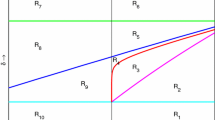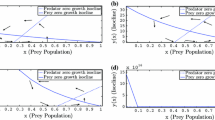Abstract
Role of additional food to predators is significant to retain biological balance for an improved ecosystem. Much attempts have been performed from the aspects of biological control and its consequences on global warming is investigated. Work has been done exhibiting the implication of mutual interference in stabilising the prey predator system which has a phenomenal impact on the dynamics of the system. In the proposed model, dynamics of additional food to predators on one-prey and two-predator system with Beddington–DeAngelis functional response is investigated. The proposed system also throws light on the role of mutual interference in predators and it differentiates the predators on the basis of the characteristic of consuming the additional food or to be solely dependent on preys for survival. Both local and global stability analysis of the system has been performed and at the end, numerical simulation is carried out which signifies the effect of changing the additional food parameters on the dynamics.








Similar content being viewed by others
References
Wackers, F.L., van Rijn, P.C.J.: Food for protection: an introduction. In: Wackers, F.L., van Rijn, P.C.J., Bruin, J. (eds.) Plant-provided food for carnivorous insects: A protective mutualism and its applications, pp. 1–14. Cambridge University Press, Cambridge (2005)
Perdikis, D., Lykouressis, D.: Effects of various items, host plants, and temperature on the development and survival of Macrolophus pygmaeus Rambur (Hemiptera: Miridae). Biol. Control 17, 5560 (2000)
Perdikis, D., Lykouressis, D.: Macrolophus pygmaeus (Hemiptera: Miridae) population parameters and biological characteristics when feeding on eggplant and tomato without prey. J. Econ. Entomol. 97, 12911298 (2004)
Perdikis, D., Lykouressis, D., Economou, L.: The influence of temperature, photo period and plant type on the predation rate of Macrolophus pygmaeus on Myzus persicae. BioControl 44, 281289 (1999)
Beddington, J.R.: Mutual interference between parasites or predators and its effect on searching efficiency. J. Anim. Ecol. 44, 331–340 (1975)
Koss, A.M., Snyder, W.E.: Alternative prey disrupt biocontrol by a guild of generalist predators. Biol. Control 32, 243–251 (2005)
Lorenzon, M., Pozzebon, A., Duso, C.: Effects of potential food sources on biological and demographic parameters of the predatory mites Kampimodromus aberrans, Typhlodromus pyri and Amblyseius andersoni. Exp. Appl. Acarol. 58, 259–278 (2012)
Put, K., Bollens, T., Wackers, F.L., Pekas, A.: Type and spatial distribution of food supplements impact population development and dispersal of the omnivore predator Macrolophus pygmaeus (Rambur) (Hemiptera: Miridae). Biol. Control 63, 172–180 (2012)
Cai, L., Yu, J., Zhu, G.: A stage-structured predator–prey model with Beddington–DeAngelis functional repsonse. J. Appl. Math. Comput. 26, 85–103 (2008)
Chattopadhayay, J., Sarkar, R., Hoballah, M.E.F., Turlings, T.C.J., Bersier, L.F.: Parasitoids may determine plant fitness—mathematical model based on experimental data. J. Theor. Biol. 212, 295–302 (2001)
Harwood, J.D., Obrycki, J.J.: The role of alternative prey in sustaining predator populations. In: Hoddle, M.S. (ed.) Proceedings of second international symposium on biological control of arthropods, Vol. II, pp. 453-462 (2005)
Srinivasu, P.D.N., Prasad, B.S.R.V., Venkatesulu, M.: Biological control through provision of additional food to predators: a theoretical study. Theor. Popul. Biol. 72, 111–120 (2007)
Srinivasu, P.D.N., Prasad, B.S.R.V.: Time optimal control of an additional food provided predator–prey system with applications to pest management and biological conservation. J. Math. Biol. 60, 591–613 (2010)
Srinivasu, P.D.N., Prasad, B.S.R.V.: Erratum to: Time optimal control of an additional food provided predator–prey system with applications to pest management and biological conservation. J. Math. Biol. 61, 591–613 (2010a)
Srinivasu, P.D.N., Prasad, B.S.R.V.: Role of quantity of additional food to predators as a control in predatorprey systems with relevance to pest management and biological conservation. Bull. Math. Biol. 73, 2249–2276 (2011)
Coll, M.: Parasitioids in diversified intercropped systems. In: Pickett, C.H., Bugg, R. (eds.) Enhancing biological control: Habitat management to promote natural enemies of argicultural pets, pp. 85–120. University of California Press, Berkely (1998)
Coll, M.: (2009) Feeding on non-prey ressources by natural enemies. In: Lundgren, J.G., Relationships of natural enemies and non-prey foods, Springer, Berlin, pp. ix–xxiii
Hagen, K.S.: Ecosystem analysis: plant cultivars (HPR), entomophagous species and food supplements. In: (Boethel, D.J., Eikenbary, R.D. (eds.), Interactions of plant resistance and parasitoids and predators of insects, Halsted, New York, pp. 151-197 (1986)
Lundgren, J.G.: Relationships of natural enemies and non-prey foods. Springer, New York (2009)
Holt, R.D., Lawton, J.H.: The ecological consequences of shared natural enemies. Annu. Rev. Ecol. Syst. 25, 495–520 (1994)
Holt, R.D.: Predation, apparent competition, and the the structure of prey communities. Theor. Popul. Biol. 12, 197–229 (1977)
Murdoch, W.W., Chesson, J., Chesson, P.L.: Biological control in thoery and practice. Am. Nat. 125, 344–366 (1985)
Hoddle, M., van Driesche, R., Sanderson, J.: Biological control of Bemisia argentifolii (Homoptera:Aleyrodidae) on Poinsettia with inundative releases of Encarsia formosa (Hymenoptera: Aphelinidae): Are higher release rates necessarily better? Biol. Control 10, 166–179 (1997)
Prasad, B.S.R.V.: Dynamics of additional food provided predator–prey system with mutually interfering predators. J. Math. Biosci. 246, 176–190 (2013)
DeLong, J.P., Vasseur, D.A.: Mutual interference is common and mostly intermediate in magnitude. BMC Ecol. 11(1), 1–8 (2011)
de Villemereuil, P.B., Lopez-Sepulcre, A.: Consumer functional responses under intra- and inter-specific interference competition. Ecol. Model. 222, 419–426 (2011)
Ginzburg, L.R., Jensen, C.X.J.: From controversy to consensus: the indirect interference functional response. Verh. Internat. Verein. Limnol. 30(2), 297–301 (2008)
Kidd, N.A.C., Jervis, M.A.: Population dynamics. In: Jervis, M.A. (ed.) Insects as natural enemies: A practical perspective, pp. 435–524. SpringerVerlag, The Netherlands (2007)
Reigadaa, C., Araujob, S.B.L., de Aguiar, M.A.M.: Patch exploitation strategies of parasitoids: The role of sex ratio and foragers interference in structuring metapopulations. Ecol. Model. 230, 11–21 (2012)
DeAngelis, D.L., Goldstein, R.A., ONeill, R.V.: A model for trophic interaction. Ecology 56, 881–892 (1975)
Cantrell, R.S., Cosner, C.: On the dynamics of predator–prey models with the Beddington–DeAngelis funcational response. J. Math. Anal. Appl. 257, 206–222 (2001)
Huang, G., Ma, W., Takeuchi, Y.: Global properties for virus dynamics models with Beddington–DeAngelis functional response. Appl. Math. Lett. 22, 1690–1693 (2009)
Hwang, T.-W.: Global analysis of the predator–prey system with Beddington–DeAngelis functional response. J. Math. Anal. Appl. 281, 395–401 (2003)
Hwang, T.-W.: Uniqueness of limit cycles of the predator-prey system with Beddington–DeAngelis functional response. J. Math. Anal. Appl. 290, 113–122 (2004)
Kratina, P., Vos, M., Bateman, A., Anhold, B.R.: Functional responses modified by predator density. Oecologia 159, 425–433 (2009)
Naji, R.K., Balasim, A.T.: Dynamical behavior of a three species food chain model with Beddington–DeAngelis functional response. Choas Solitons Fractals 32, 1853–1866 (2007)
Negi, K., Gakkhar, S.: Dynamics in a Beddington–DeAngelis preypredator system with impulsive harvesting. Ecol. Model. 206, 421–430 (2007)
Skalski, G.T., Gilliam, J.F.: Functional responses with predator interference: Viable alternatives to the Holling type II model. Ecology 82, 3083–3092 (2001)
Dimitrov, D.T., Kojouharov, H.V.: Complete mathematical analysis of predator–prey models with linear prey growth and Beddington–DeAngelis functional response. Appl. Math. Comput. 162, 523–538 (2005)
Nagumo, M.: Uber die Lage der Integralkurven gew onlicher Differentialgeichungen. Proc. Phys. Math. Soc. Jpn. 24, 555 (1942)
Birkhoff, G., Rota, G.C.: Ordinary Differential Equations. Ginn Boston (1982)
Kar, T.K., Ghosh, Bapan: Sustainability and optimal control of an exploited prey predator system through provision of alternative food to predator. Biosystems 109(2), 220–232 (2012)
Sahoo, Banshidhar, Poria, Swarup: Effects of supplying alternative food in a predator prey model with harvesting. Appl. Math. Comput. 234, 150–166 (2014)
Sahoo, Banshidhar, Poria, Swarup: Disease control in a food chain model supplying alternative food. Appl. Math. Model. 37(8), 5653–5663 (2013)
Skalaki, Garrick T., Gilliam, James F.: Functional responses with predator interferenve: Viable alternatives to the Holling type II model. Ecol. Soc. Am. 82(11), 3083–3092 (2001)
Harrison, Gary W.: Global stability of predator–prey interactions. J. Math. Biol. 8(2), 159–171 (1979)
Chen, Fengde: On a nonlinear nonautonomous predator–prey model with diffusion and distributed delay. J. Comput. Appl. Math. 180, 33–49 (2005)
Hsu, Sze-Bi, Huang, Tzy-Wei: Global stability for a class of predator–prey systems. SIAM J. Appl. Math 55(3), 763–783 (1995)
Acknowledgements
Authors are grateful to Professor Balram Dubey, BITS Pilani for the valuable suggestions and constant inspiration while preparing this paper.
Author information
Authors and Affiliations
Corresponding author
Rights and permissions
About this article
Cite this article
Arora, C., Kumar, V. Dynamics of One-prey and Two-predator System Highlighting the Significance of Additional Food for Predators with Beddington–DeAngelis Functional Response. Differ Equ Dyn Syst 30, 411–431 (2022). https://doi.org/10.1007/s12591-018-0442-6
Published:
Issue Date:
DOI: https://doi.org/10.1007/s12591-018-0442-6




